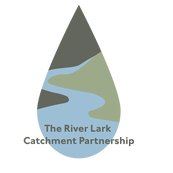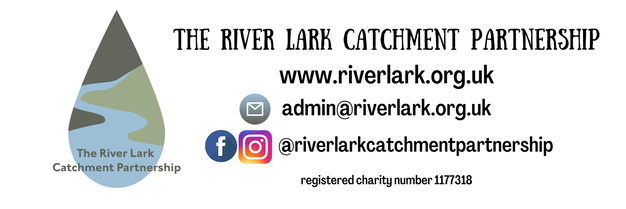River Lark Corridor Strategy
Input to the West Suffolk Local Plan
The River Lark Catchment Partnership (RLCP) proposes that the forthcoming West Suffolk Local Plan should include a River Lark Corridor Strategy. This comprises an overall river catchment approach to planning policy across West Suffolk, the development of that approach along the River Lark Corridor and the designation of suggested sites as Local Green Space along the corridor throughout West Suffolk.
The start of the West Suffolk Plan was delayed by extended revisions to the Forest Heath District Plan and was launched in December 2018 with a call for potential development sites. The initial work is continuing with the collection of evidence and invitations to local communities to contribute ‘concerns and proposals’.
This first RLCP input to the West Suffolk Local Plan in early autumn 2019 will comprise initial papers and maps and a request for an informal discussion meeting with planners. The RLCP may then submit revised versions of these maps and papers as a more formal contribution to the planning process. The next stage of the Local Plan will be a public consultation on ‘Issues and Options’ in Autumn 2019. The RLCP will review the consultation report, focussing in particular on its initial input on a proposed River Lark Corridor Strategy, and it will then submit formal comments accordingly.
River Lark Catchment
The RLCP has examined various river catchment issues through a series of maps and a written commentary covering most of West Suffolk. The issues include river flow, water quality, river ecology, biodiversity, water supply and sewerage treatment covering the whole water cycle throughout the catchment area.
The RLCP aims to promote catchment wide policies and projects that
The RLCP proposes that these issues should be included in the assessment of options for housing, employment and other development across West Suffolk as well contributing to the determination of planning applications for specific developments at the local level.
River Lark Corridor
The RLCP would like to see the river catchment approach it has outlined for the whole catchment applied to the River Lark Corridor itself. It would like to see the conservation and management of the river corridor built into the new Local Plan to protect and enhance the natural and built environment and heritage and the recreational amenities for local people, visitors and water users. The River Lark catchment is rich in biodiversity, for both species and habitats. No fewer than five UK Biodiversity Action Plan (BAP) Priority Habitats occur along the river corridor. The river also supports several UK BAP Species, many of which are in decline.
Spring-fed chalk streams are just one of the UK BAP Priority Habitats and, despite being the most valuable freshwater habitat in the Brecks, they face many pressures and are generally under-protected and under-valued. The Environment Agency’s ‘State of England’s Chalk Streams’ report found that over three quarters of chalk streams in the UK are not in good health. The RLCP believes a catchment-based approach is the best way to restore and protect these special rivers and to raise awareness of the value of this globally significant habitat. The RLCP has defined the river corridor according to the landscape character areas identified in previous studies by Suffolk County Council and the former St Edmundsbury Borough Council. It has reviewed available information on the river catchment issues and more local features such as heritage assets and recreational amenities in the context of its practical river conservation work with the Environment Agency and others.
Local Green Space
The RLCP has focussed particularly on the need and opportunity to suggest potential sites for the designation of Local Green Space along the River Lark Corridor in accordance with the provisions of the National Planning Policy Framework (NPPF, 2018). This would recognise the importance of the local green spaces to local people and to protect them from pressures for development as if they were designated Green Belt. The RLCP has also consulted its members on a range of potential sites that could meet the criteria set out in the NPPF including close proximity to the community, local significance to the community and local scale character. It has produced a series of draft maps of various sections along the River Lark Corridor showing potential sites that it would like to be considered for designation as part of the West Suffolk Local Plan. The RLCP has also prepared a systematic assessment of the suitability of potential sites for Local Green Space designation against the criteria set out in the NPPF (see full document and table attached). These suggestions are put forward as a basis for discussion.
Input to the West Suffolk Local Plan
The River Lark Catchment Partnership (RLCP) proposes that the forthcoming West Suffolk Local Plan should include a River Lark Corridor Strategy. This comprises an overall river catchment approach to planning policy across West Suffolk, the development of that approach along the River Lark Corridor and the designation of suggested sites as Local Green Space along the corridor throughout West Suffolk.
The start of the West Suffolk Plan was delayed by extended revisions to the Forest Heath District Plan and was launched in December 2018 with a call for potential development sites. The initial work is continuing with the collection of evidence and invitations to local communities to contribute ‘concerns and proposals’.
This first RLCP input to the West Suffolk Local Plan in early autumn 2019 will comprise initial papers and maps and a request for an informal discussion meeting with planners. The RLCP may then submit revised versions of these maps and papers as a more formal contribution to the planning process. The next stage of the Local Plan will be a public consultation on ‘Issues and Options’ in Autumn 2019. The RLCP will review the consultation report, focussing in particular on its initial input on a proposed River Lark Corridor Strategy, and it will then submit formal comments accordingly.
River Lark Catchment
The RLCP has examined various river catchment issues through a series of maps and a written commentary covering most of West Suffolk. The issues include river flow, water quality, river ecology, biodiversity, water supply and sewerage treatment covering the whole water cycle throughout the catchment area.
The RLCP aims to promote catchment wide policies and projects that
- improve water quality and reduce pollution
- improve river flows and mitigate flood risk
- bring a balance to aquifer abstractions and improve environmental flows in rivers
- conserve and enhance the natural ecology of the river system
The RLCP proposes that these issues should be included in the assessment of options for housing, employment and other development across West Suffolk as well contributing to the determination of planning applications for specific developments at the local level.
River Lark Corridor
The RLCP would like to see the river catchment approach it has outlined for the whole catchment applied to the River Lark Corridor itself. It would like to see the conservation and management of the river corridor built into the new Local Plan to protect and enhance the natural and built environment and heritage and the recreational amenities for local people, visitors and water users. The River Lark catchment is rich in biodiversity, for both species and habitats. No fewer than five UK Biodiversity Action Plan (BAP) Priority Habitats occur along the river corridor. The river also supports several UK BAP Species, many of which are in decline.
Spring-fed chalk streams are just one of the UK BAP Priority Habitats and, despite being the most valuable freshwater habitat in the Brecks, they face many pressures and are generally under-protected and under-valued. The Environment Agency’s ‘State of England’s Chalk Streams’ report found that over three quarters of chalk streams in the UK are not in good health. The RLCP believes a catchment-based approach is the best way to restore and protect these special rivers and to raise awareness of the value of this globally significant habitat. The RLCP has defined the river corridor according to the landscape character areas identified in previous studies by Suffolk County Council and the former St Edmundsbury Borough Council. It has reviewed available information on the river catchment issues and more local features such as heritage assets and recreational amenities in the context of its practical river conservation work with the Environment Agency and others.
Local Green Space
The RLCP has focussed particularly on the need and opportunity to suggest potential sites for the designation of Local Green Space along the River Lark Corridor in accordance with the provisions of the National Planning Policy Framework (NPPF, 2018). This would recognise the importance of the local green spaces to local people and to protect them from pressures for development as if they were designated Green Belt. The RLCP has also consulted its members on a range of potential sites that could meet the criteria set out in the NPPF including close proximity to the community, local significance to the community and local scale character. It has produced a series of draft maps of various sections along the River Lark Corridor showing potential sites that it would like to be considered for designation as part of the West Suffolk Local Plan. The RLCP has also prepared a systematic assessment of the suitability of potential sites for Local Green Space designation against the criteria set out in the NPPF (see full document and table attached). These suggestions are put forward as a basis for discussion.
| 2019-11_rlcp_synopsis_for_west_suffolk_local_plan_-_revised_and_re-issued__30102019.pdf |
| 2022-12_west_suffolk_green_infrastructure_-_final_may_2022.pdf |

